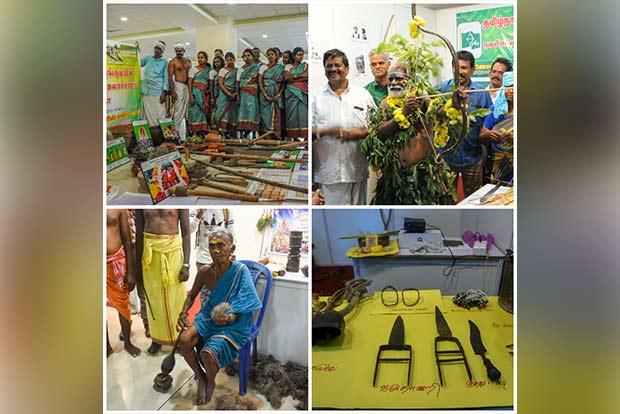Begin typing your search...
City gains insight into Adivasi way of life
Right from Irulas to Kattunayakans, visitors got to enjoy the heritage, lifestyle, dance and music of 16 tribal communities from TN at the State Tribal Festival organised by the Tribal Research Centre, Tamil Nadu.

Chennai
Walking into Kalaivanar Arangam on Friday, one might not have gotten the best first impression of Pazhankudi Nadham, a State Tribal Festival organized by the Tribal Research Centre, Tamil Nadu. Only upon taking a closer look and interacting with some of these Adivasis could he/she come to know of their true colours. As many as 16 different tribal communities had gathered from across the state to showcase their traditions, culture, performances and handicrafts — all with the common aim of gaining visibility in the public and government’s eye and improving their standard of living.
An individual walked up to the DTNext team and introduced himself as Ram, a fitness trainer in Chennai. “My family sent me here from the forests in search of education and a better livelihood,” revealed the youngster, who belongs to the primitive Kattunayakan tribal community. “But now, we’re stuck here neither able to move forward or go back to our roots — so it’s nice that through festivals like this, we’re able to shine light on our current situation,” he added.
At that moment, a distant relative of his from their native place asked us to ‘poke’ a metal stick in between the fading pages of an olaichudi (booklet made of palm leaves). It had different inscriptions made with a needle-like instrument. “While the men of our community would go off to hunt before it was banned, the women didn’t know how to pass time. So, they would descend from the hills into neighbouring villages to read out predictions written on the palm leaves. Depending on which pages a person poked the metal stick in between, the fortune teller would give them either good or bad news about their past, present and future in exchange for a few paise,” explained Dinesh, another Kattunayakan settled here.
Thanking them for the insights, we moved on to the next stall that contained clothes, handwoven baskets, bamboo containers and other artefacts on display for sale by the Tribal Cooperative Marketing Development Federation of India Ltd. Jayashree, who was manning the stall, said, “We reach out to tribal communities across India to procure these handicrafts from them. In places that are so remote that basic necessities or information don’t reach, we offer to train the Adivasis in some vocational skills (after identifying their needs) to improve their quality of life.”
The Konda Reddi tribe has a strong connect with nature — like most of the indigenous peoples we met at Pazhankudi Nadham — and it’s evident in the lifestyle they lead. A fifth generation vaithyar (local doctor) had to say, “Right from sorakai (bottle gourd) containers that we use to store grains or jewellery to the medication we use, everything comes from nature and has a scientific purpose. We care about the creatures around us so much that in order to prevent wild animals from stealing our livestock or pet dogs at night, we created collars from metal, chains and bells much before the British invaded India,” he smiled. Before heading back to demonstrating how an udumbu (percussion instrument) works to the onlookers, he summed up, “I’m glad you’re writing about all of us. We want the world to know and benefit from the knowledge of us malaialigal (tribes of the hills).”
Visit news.dtnext.in to explore our interactive epaper!
Download the DT Next app for more exciting features!
Click here for iOS
Click here for Android
Next Story



